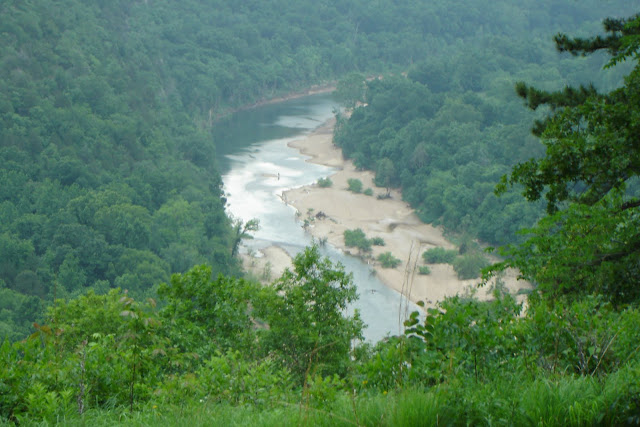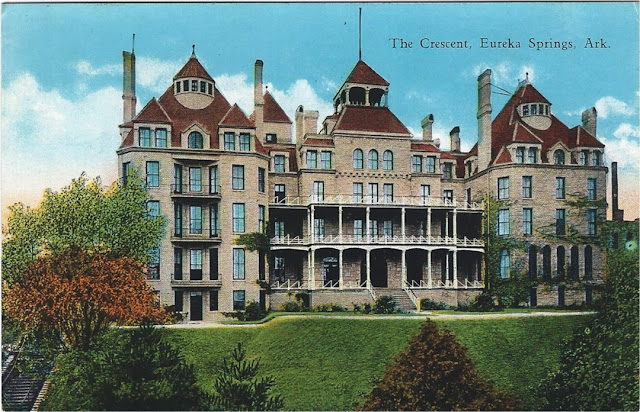
One of the most discussed and written about Arkansas landmarks, the 1886 Crescent Hotel and Spa bears mention for so much unusual history. Billed as "America's Most Luxurious Resort Hotel" by its builders, it has become self-described in this millennium as "America's Most Haunted Hotel." As a member of the Historic Hotels of America, National Trust for Historic Preservation and added in February 2016 to the National Register of Historic Places, The Crescent Hotel has known many incarnations. Built first as a resort for the wealthy, it was also a college for girls and a notorious hospital run by a con man before becoming a hotel and spa.

Billed as “America’s Most Haunted Hotel” the 1886 Crescent Hotel and Spa has been restored and welcomes guests from all over the world. Ghost tours are offered nightly as well as stories around the campfire. Many of the hotel’s ghosts are referred to fondly. Guests contribute to the stories, posting their own experiences to the hotel’s Facebook page. The ghost tours take one through almost the entire hotel, including the basement where Dr. Norman G. Baker had his morgue. The stops along the way introduce the many ghosts and their stories. Some experiences of guests and hotel staff are told. It isn’t an experience for the faint of heart or the extremely superstitious. At Halloween, special tours are conducted for those seeking a spooky experience for the holiday.

The ghosts of the hotel seem to come from every incarnation of its history. The most morbid period, when it was run as a “cancer hospital” by self-described doctor, Norman Baker, has given the Crescent the spookiest part of its reputation. The show Ghost Hunters, a SciFi Channel series, recorded a show in Eureka Springs, focusing mainly on the Crescent. They recorded what appeared to be an apparition in the basement area with a thermal imaging camera that surprised even the seasoned paranormal investigators.
The hotel sits at the highest point in a very hilly town. It can be seen from most points in the quaint town of Eureka Springs. Visitors can enjoy rooftop dining and a wonderful view of the town.
I visited the Crescent in the summer of 2015 with a friend and experienced its charm, beauty, and eeriness for myself. We wanted the whole experience, so signed up for the ghost tour available each evening. After checking in, my friend and I decided to explore the hotel before dinner. Traversing the stairs and landings, I stopped at each floor to look below. It was at one of these that I experienced a feeling I'm not sure I can describe, but it made me step back from the railing. Shaking it off, I stepped forward again and experienced the same feeling. It was a little stronger. I stepped back and decided I wouldn't repeat the experience.
After a lovely dinner on the roof terrace, complete with a couple of strong drinks (maybe for courage?), we took the after dark ghost tour. Our guide was dressed in period costume and started us all with a history of the hotel as well as a brief history of each of the ghosts. There are at least 5 human ghosts and one cat! As we toured the halls, I was more than a little spooked to discover that the spot on the landing where I had experienced that odd feeling was the approximate area where a child had fallen to her death.
The only other spot on the tour that spooked me more than a little was the area in the basement where the SciFi Channel show Ghost Hunters had filmed the apparition that actually frightened them. I thought I had caught something out of the corner of my eye (My imagination? Had to be!) and the hair on the back of my neck actually stood on end.
Like Hot Springs, Eureka Springs became world renown back in the 1800s for its springs. It seems to be a mark of the Victorian era that, "taking the waters,” was a way to heal the body and cleanse the soul. Because of these beliefs, true or not, both towns experienced a tourist boom that lasted through two different centuries.

It was those springs and the claims that they helped to cure illnesses that brought a world-class charlatan and con man to the Crescent Hotel in the late 1930s. Norman Baker, who proclaimed himself a physician, had his own radio show and used it to promote a "cancer cure" that he distributed worldwide. Apparently, he saw the Crescent, abandoned for the past 3 years as an opportunity he could not pass up. Purchasing the hotel and renaming it the Baker Hospital, he again used his radio show to promote his cure for cancer, claiming that the healing waters of Eureka Springs added to the cure would allow patients to leave cancer free. The horror story that followed led to "Doctor" Baker's arrest by the federal government and his imprisonment for fraud. It also seems to be the major factor in contributing to the Crescent's spooky reputation.
There are at least two ghosts attached to the hotel before Norman Baker's term; one when the hotel was being constructed, a young stonemason named Michael who fell to his death and the other a young girl who was a student while it was the Crescent College and Conservatory for Young Girls. The rest of the ghosts seem to be from the time period when it was more of a house of horrors than the hospital it was claimed to be.
Our good "Doctor" Baker lured cancer patients to his hospital with claims that he could cure cancer without surgery. What happened instead was that most of his patients died and many were probably incinerated in the basement. Patients appeared to have a habit of leaving in the middle of the night (odd time to leave a hospital). When other patients would inquire where so and so was, Baker would happily proclaim that they had been cured and could not wait to return home to loved ones. He also took advantage of the patients as they became weaker, persuading them to sign over a power of attorney so that he could rob them after they died as well. From the federal investigation that followed his arrest, it appears that Norman Baker was raking in over $500,000 a year on his elixir and had defrauded patients out of more than four million dollars. It was never proved that he actually murdered anyone, but proof did exist that he was negligent in the care of his charges and more than ample proof that he defrauded people by mail and at his hospital.
Norman Baker, although he apparently did not directly murder his patients, may compete with H.H. Holmes, one of the first documented serial killers, in body count. During the 1893 World's Columbian Exposition in Chicago, he lured people to a hotel he designed and built with murder in mind. Although he confessed to 27 murders, it is believed his body count was upwards of 200.

For the most part, the ghosts at the 1886 Crescent Hotel & Spa appear to be benign or a bit mischievous. Many visitors, as well as staff, have had their own ghostly encounters and post to Facebook. It is worth a visit for the view alone as the Crescent is located above the town of Eureka Springs and one can see nearly the whole town from the Sky Bar terrace and many of the rooms in the hotel. Do be willing to take the Ghost Tour and learn why your jewelry was misplaced along with your shoes or you had that funny feeling in this particular spot. Did you feel a furry brush on your leg? You may find out about that as well. It isn't the two current resident cats.


















































